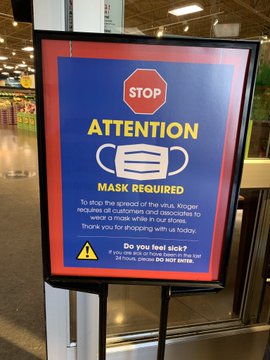I am old enough to remember the late 1970s and early 1980s. The United States was stuck in what some called ‘stagflation,’ with stagnant economic growth coupled with high inflation. Former Governor Ronald Reagan (R-CA) used what he called the ‘misery index,’ the total of the inflation and unemployment rates to hammer President Jimmy Carter right out of office in the 1980 election.
Christopher Rugaber of the Associated Press wrote an article entitled,[1]Article titles in newspapers are more commonly written by the papers’ editors than the authors, so Mr Rugaber may not have written the article title. in The Philadelphia Inquirer, U.S. inflation might have hit a 40-year high in January: Economists have forecast that when the Labor Department reports January’s inflation figures Thursday, it will show that consumer prices jumped 7.3% compared with 12 months ago, saying:
- Economists have forecast that when the Labor Department reports January’s inflation figures Thursday, it will show that consumer prices jumped 7.3% compared with 12 months ago, according to data provider FactSet. That would be up from a 7.1% year-over-year pace in December and would mark the biggest such increase since February 1982.
Well, the unnamed economists got it wrong: it was 7.5%!
Prices climbed 7.5% in January compared with last year, continuing inflation’s fastest pace in 40 years
High inflation is undermining a robust recovery, testing policymakers at the Federal Reserve and White House
By Rachel Siegel and Andrew Van Dam | Thursday, February 10, 2022 | 8:32 AM EST
Prices continued their upward march in January, rising by 7.5 percent compared with the same period a year ago, the fastest pace in 40 years.Inflation was expected to climb relative to last January, when the economy reeled from a winter coronavirus surge with no widespread vaccines. Today’s new high inflation rate reflects all the accumulated price gains, in gasoline and other categories, built up in a tumultuous 2021.
In the shorter term, data released Thursday by the Bureau of Labor Statistics also showed prices rose 0.6 percent in January compared with December, same as the November to December inflation rate, which officials revised upward slightly.
As with previous months, higher prices reached into just about every sector of the economy, leaving households to feel the strain at the deli counter, shopping mall and just about everywhere else.
There’s more at the original.
That photo, taken by me on Groundhog Day? On Tuesday, February 8th, 87 Octane regular gasoline was up to $3.259 per gallon locally.
President Reagan, who defeated President Carter by a large margin, saw the Republican Party lose a significant number of seats in the 1982 elections as inflation remained high and recession struck.
- Sharp inflation has undermined an otherwise robust recovery. The economy has rebounded remarkably since plunging into recession almost two years ago. Over the past 12 months, the U.S. economy has added nearly 7 million jobs and average hourly earnings have climbed 5.7 percent. The overall economy has shown relative resilience to new waves of the coronavirus, and stocks have bounced back from their volatile start to 2022.
If wages have risen 5.7%, but inflation is at 7.5%, it’s pretty simple: American workers are falling behind, are becoming poorer in relative terms.
- High inflation has left an indelible mark on the economy, including the highest price increases for housing, food and energy that many workers have ever seen. And questions loom about how or whether policymakers will be able to rein prices back in without slowing the recovery or even causing another recession. The answers will have enormous implications for policymakers at the Federal Reserve and in the Biden administration.
That has always been the problem, and was a large part of the problem that faced Presidents Carter and Reagan; the halting of inflation meant a recession.
The timing is different this year: we are not in a recession, but if there is one, after the elections, and it persists into 2023 and 2024, it could encourage the voters to throw the Democrats out of the White House. The Republicans will point out that the economy was strong, with very low inflation, during President Trump’s term, prior to the COVID-19 outbreak and the government’s draconian response to it, much of it ordered by state governors rather than the President.
The President doesn’t really control the economy — no one does — but he normally gets either the credit for a good economy or the blame for a bad one. Come election day, I will be very happy to see Joe Biden get the blame for a bad economy!
References
| ↑1 | Article titles in newspapers are more commonly written by the papers’ editors than the authors, so Mr Rugaber may not have written the article title. |
|---|





 The American people have become just plain tired of all of the COVID-19 restrictions, and
The American people have become just plain tired of all of the COVID-19 restrictions, and 


